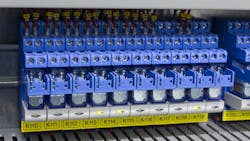The Future—and Present—of Distributed Control
The use of motor management relays, or MMRs, have shown to be effective not just to manage motors, but as an asset to the larger control system. As a new Machine Design article notes, the expanded use of such distributed control offers greater system flexibility.
As Jim Rosner, an industrial application engineer in the controls and power conversion division at Eaton notes in this article, “Distributed control can be implemented in conjunction with a main controller to offload critical logic or it can be used as the system controller. The latter could be the system of the future, especially if cloud technology and IIoT is taken into consideration as the overall system monitoring tool. But an HMI in a control room or on the MCC or panel door can also be used for this purpose.”
Let Your Cobot do the Tending
One obvious advantage of a robot is its ability to stand in place for long periods without muscle fatigue or boredom. This makes their use in machine tending an equally obvious value.
An upcoming Machine Design webinar will look at how to set up a machine tending automation cell with cobots. Presenters from Universal Robots and VersaBuilt Robotics will share how to set up a machine tending application that can help redeploy employees to more value-added tasks while improving overall productivity.
A Mighty, Small Idea
Liquid silicone rubber technology produces a single component instead of separate parts that need to be assembled, and it has several advantages for the medical device manufacturer. As a recent Machine Design article notes, “it reduces production costs and supply chain costs associated with stocking and handling multiple parts. The single, integrated device has greater integrity and removes undesirable spaces where bacteria can grow, eliminating the risk of contamination.”
Author Ursula Nollenberger of Trelleborg Sealing Solutions writes, “Silicone is ideal for medical devices and equipment, not only because it’s inert, biostable and biocompatible, but also because it can be processed in many ways. It can be molded on its own, but the real magic happens when it is combined during the molding process with engineered plastics and other substrates in what is termed multicomponent manufacturing.”
About the Author

Bob Vavra
Editor Emeritus, Machine Design and Power & Motion
Bob Vavra is the former senior content director of Machine Design and Power & Motion.
